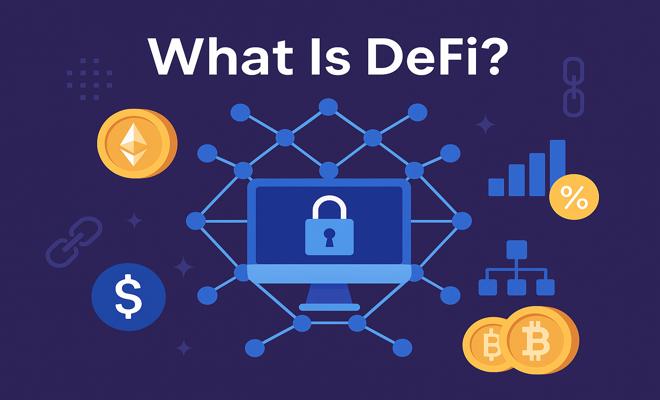
What Is DeFi? A Complete Guide to Decentralized Finance
The financial landscape is undergoing a major transformation, and Decentralized Finance (DeFi) is leading the charge. But what exactly is DeFi, and why is it becoming such a hot topic worldwide?
In this detailed guide, we’ll break down the basics of DeFi — from how it works and why it matters, to its benefits, risks, and exciting future possibilities. Whether you’re new to cryptocurrency or just curious about this innovative movement, this article will help you understand DeFi in simple, clear terms.
🔍 What Is DeFi?
At its core, DeFi is a collection of financial services built on blockchain technology that works without traditional middlemen like banks or brokers. Instead, it uses smart contracts — which are self-executing computer programs running on decentralized blockchains — to automatically carry out and enforce transactions.
Unlike traditional finance where a few institutions hold control, DeFi is permissionless. This means anyone with an internet connection can use these services freely, without needing approval from banks or authorities.
The goal of DeFi is to create a more open, transparent, and efficient financial system where users have full control over their money.
🧩 Where Did DeFi Come From?
The DeFi journey started with Bitcoin in 2009, which introduced decentralized digital money. But Bitcoin mainly focuses on transferring value between people.
The real breakthrough came in 2015 with Ethereum, a blockchain that allowed developers to write smart contracts and create decentralized apps (DApps). This made it possible to build complex financial tools without middlemen — the foundation for today’s vibrant DeFi ecosystem.
⚙️ How Does DeFi Actually Work?
Most DeFi platforms run on public blockchains, with Ethereum being the most popular. Here’s a simple overview of the process:
- 👤 User Access: People use DeFi apps via crypto wallets like MetaMask or Trust Wallet.
- 📜 Smart Contracts: When a user takes an action — like lending or swapping tokens — the instructions go to a smart contract.
- ⛓️ Blockchain Verification: The blockchain network confirms and secures the transaction.
- ✅ Automatic Execution: The smart contract completes the transaction without human help, such as sending loans or updating balances.
💡 Key Features of DeFi
- Decentralization: No single person or company controls the system, reducing risks of censorship or failure.
- Permissionless Access: Anyone, anywhere can participate without needing permission.
- Transparency: All transactions and contract codes are public and auditable on the blockchain.
- Composability: DeFi protocols can work together like “money legos,” creating new services.
- Programmability: Smart contracts let developers automate and customize financial products.
🔥 Popular DeFi Applications
🔄 Decentralized Exchanges (DEXs)
DEXs such as Uniswap and SushiSwap let users trade cryptocurrencies directly, without middlemen. They use automated market makers (AMMs) — liquidity pools funded by users — instead of traditional order books.
💰 Lending and Borrowing
Platforms like Aave and Compound let users lend their crypto to earn interest or borrow money by putting up crypto as collateral — all without credit checks or banks.
🔒 Stablecoins
Stablecoins such as USDC and DAI are cryptocurrencies tied to real-world currencies like the US dollar. They provide price stability and are crucial for DeFi transactions and collateral.
🌾 Yield Farming & Liquidity Mining
Users can earn rewards by staking tokens or providing liquidity to DeFi protocols. These rewards often come as native tokens, encouraging more people to join and add liquidity.
🛡️ Insurance
DeFi insurance projects like Nexus Mutual offer protection against risks such as smart contract bugs or hacks, helping reduce losses for users.
🧪 Derivatives and Synthetic Assets
Protocols like Synthetix enable trading synthetic assets that track real-world things like stocks, commodities, or indexes — all on the blockchain.
🌟 Benefits of DeFi
- Global Access: Anyone worldwide with internet can use DeFi, no matter their location or banking status.
- Transparency & Trust: Open smart contracts and public ledgers reduce the need to trust third parties.
- Lower Fees: Removing intermediaries cuts costs significantly.
- Innovation: New financial products like flash loans and automated portfolios become possible.
- User Control: You keep custody of your assets, interacting directly with protocols.
⚠️ Challenges & Risks
- Smart Contract Bugs: Errors or hacks can cause loss of funds — some high-profile exploits have cost millions.
- Regulatory Uncertainty: Rules around DeFi are still evolving globally, which may impact its growth.
- Market Volatility: Crypto prices can fluctuate wildly, risking collateral and liquidity.
- Scams & Fraud: Open access means some projects might be unreliable or fraudulent.
- User Experience: Complex interfaces, gas fees, and key management can be difficult for beginners.
🔮 What Does the Future Hold for DeFi?
Despite challenges, DeFi is growing fast. Layer 2 solutions like Polygon improve speed and cut costs, while cross-chain bridges are enabling different blockchains to work together smoothly.
Eventually, DeFi might blend with traditional finance (TradFi), creating hybrid systems that offer decentralization while meeting regulatory demands.
“Decentralized Finance promises to democratize access to financial services and reshape the global economy.” — Industry Expert
📚 How to Start Using DeFi
- Set up a cryptocurrency wallet like MetaMask.
- Buy some cryptocurrency (for example, Ethereum) from an exchange to pay transaction fees.
- Explore popular DeFi platforms, starting with decentralized exchanges or lending services.
- Begin with small amounts and research each platform carefully to understand risks and benefits.
- Keep learning about security best practices to protect your assets.
📝 Final Thoughts
Decentralized Finance is revolutionizing how we interact with money — allowing peer-to-peer transactions without traditional middlemen. By combining blockchain technology and smart contracts, DeFi offers greater transparency, accessibility, and innovation.
While there are risks, ongoing improvements and clearer regulations will help DeFi reach its full potential, reshaping the financial world for the better.
No matter if you’re a developer, investor, or just curious, understanding DeFi is key to being part of the future of finance. 🌍💡